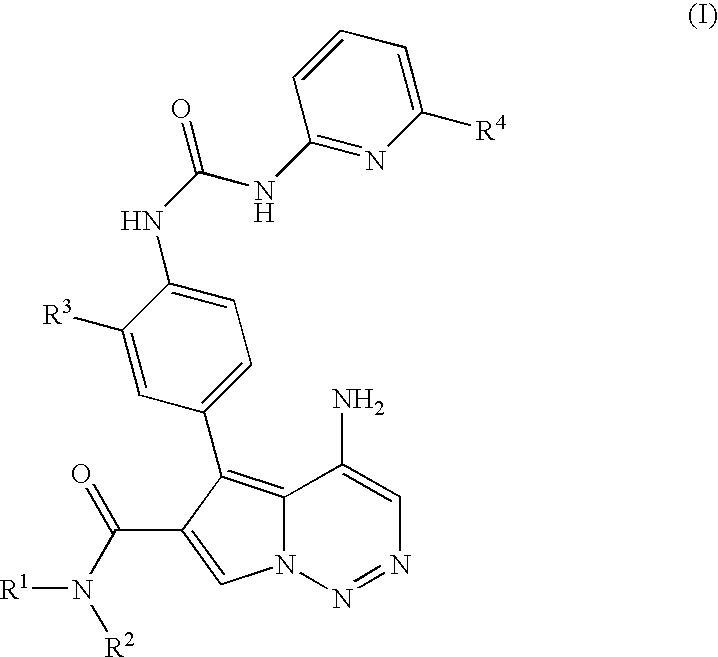Pyrrolotriazine derivatives useful for treating cancer through inhibition of aurora kinase
a technology of aurora kinase and pyrrolotriazine, which is applied in the direction of chemical treatment enzyme inactivation, drug composition, pharmaceutical packaging, etc., can solve the problems of loss of cell cycle regulation, uncontrolled cell growth and tissue homeostasis,
- Summary
- Abstract
- Description
- Claims
- Application Information
AI Technical Summary
Benefits of technology
Problems solved by technology
Method used
Image
Examples
example 1
Preparation of 4-amino-5-(3-fluoro-4-{[(6-methylpyridin-2-yl)carbamoyl]amino}phenyl)-N-methylpyrrolo[2,1-9 [1,2,4]triazine-6-carboxamide
[0326]
[0327]Intermediate I (75 mg, 0.18 mmol) was added to a mixture methylamine hydrochloride (60 mg, 0.89 mmol), benzotriazolyloxytris(dimethylamino)phosphonium PF6 (118 mg, 0.27 mmol) and 4-methylmorpholine (90 mg, 0.89 mmol) in DMF (2 mL). The reaction was stirred at it for 16 h and then filtered. The filtrate was subjected to HPLC purification using a gradient elution from 25% to 85% acetonitrile in water to give the desired product (25 mg, 32%); 1H NMR (300 MHz, DMSO-d6) δ 9.93 (s, 1H), 8.32 (dd, J=8.4, 8.4 Hz, 1H), 8.07 (s, 1H), 7.90 (s, 1H), 7.88-7.97 (br s, 1H), 7.66 (dd, J=7.8, 7.8 Hz, 1H), 7.30 (dd, J=11.9, 1.9 Hz, 1H), 7.12 (dd, J=8.4, 1.8 Hz, 1H), 6.93-7.03 (br d, 1H), 6.90 (d J=7.4 Hz, 1H), 2.63 (d, J=4.6 Hz, 3H), 2.46 (s, 3H); ES-MS m / z 435.1 (MH)+; HPLC RT (Method A) 1.80 min.
example 2
Preparation of 4-amino-N-ethyl-5-(3-fluoro-4-{[(6-methylpyridin-2-yl)carbamoyl]amino}phenyl)pyrrolo[2,1-f][1,2,4]triazine-6-carboxamide
[0328]
[0329]The procedure used for the preparation of Example 1 was used to prepare the title compound by substituting ethylamine hydrochloride for methylamine hydrochloride. 1H NMR (300 MHz, DMSO-d6) δ 9.93 (s, 1H), 8.32 (dd, J=8.4, 8.4 Hz, 1H), 8.09 (s, 1H), 7.90 (s, 1H), 7.84-7.95 (br s, 1H), 7.66 (dd, J=7.7, 7.7 Hz, 1H), 7.30 (dd, J=12.0, 1.8 Hz, 1H), 7.12 (dd, J=8.4, 1.7 Hz, 1H), 6.96-7.05 (br d, 1H), 6.90 (d J=7.4 Hz, 1H), 3.06-3.19 (m, 2H), 2.46 (s, 3H), 1.08 (t, J=7.2 Hz, 3H); ES-MS m / z 449.1 (MH)+; HPLC RT (Method B) 2.44 min.
example 3
Prepration of 4-amino-5-(3-fluoro-4-{[(6-methylpyridin-2-yl)carbamoyl]amino}phenyl)-N-propylpyrrolo[2,1-f][1,2,4]triazine-6-carboxamide
[0330]
[0331]The procedure used for the preparation of Example 1 was used to prepare the title compound by substituting propylamine for methylamine hydrochloride. 1H NMR (300 MHz, DMSO-d6) δ 9.93 (s, 1H), 8.32 (dd, J=8.5, 8.5 Hz, 1H), 8.09 (s, 1H), 7.90 (s, 1H), 7.86 (dd, J=5.7, 5.7 Hz, 1H), 7.66 (dd, J=7.8, 7.8 Hz, 1H), 7.30 (dd, J=12.2, 2.0 Hz, 1H), 7.12 (dd, J=8.3, 1.7 Hz, 1H), 6.95-7.04 (br d, 1H), 6.90 (d J=7.4 Hz, 1H), 3.05 (q, J=6.5 Hz, 2H), 2.45 (s, 3H), 1.33-1.44 (m, 2H), 0.79 (t, J=7.4 Hz, 3H); ES-MS m / z 463.1 (MH)+; HPLC RT (Method B) 2.59 min.
PUM
| Property | Measurement | Unit |
|---|---|---|
| concentration | aaaaa | aaaaa |
| flow rate | aaaaa | aaaaa |
| wavelength | aaaaa | aaaaa |
Abstract
Description
Claims
Application Information
 Login to View More
Login to View More - R&D
- Intellectual Property
- Life Sciences
- Materials
- Tech Scout
- Unparalleled Data Quality
- Higher Quality Content
- 60% Fewer Hallucinations
Browse by: Latest US Patents, China's latest patents, Technical Efficacy Thesaurus, Application Domain, Technology Topic, Popular Technical Reports.
© 2025 PatSnap. All rights reserved.Legal|Privacy policy|Modern Slavery Act Transparency Statement|Sitemap|About US| Contact US: help@patsnap.com



